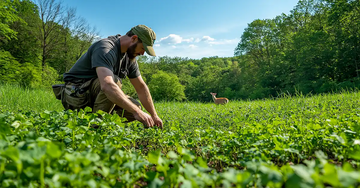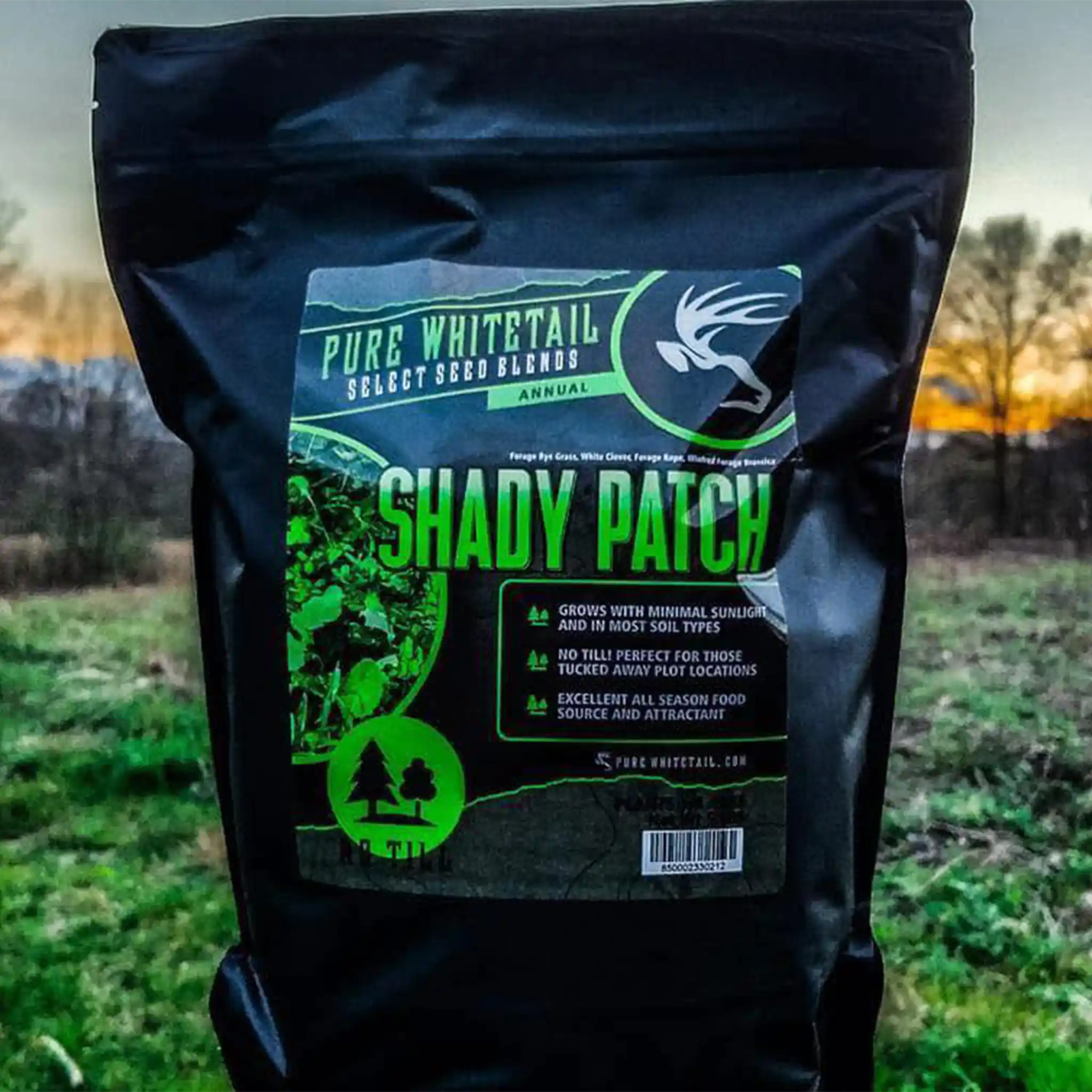
Ultimate Spring Food Plot Planting Guide for Whitetail Deer (2025 Edition)
Spring is here, and for whitetail deer hunters, that means one thing: it’s time to plant food plots. Whether you’re preparing for next fall’s trophy buck or boosting herd health year-round, a well-planned spring food plot can make all the difference. In this guide, we’ll walk you through everything you need to know to create a successful whitetail food plot in spring 2025—from timing and soil prep to choosing the best seeds and maintaining your plot. Let’s get started with the ultimate spring food plot planting guide.
Why Plant Food Plots in Spring?
Spring planting (March through May) sets the stage for lush, nutrient-rich food plots that attract whitetail deer when they need it most. Does are recovering from winter and raising fawns, while bucks are growing antlers—both rely on quality forage. A spring food plot also gives you a head start on weed control and soil health, ensuring your plot thrives by hunting season. Ready to learn how to plant a food plot that delivers? Here’s the step-by-step process.
Step 1: Timing Your Spring Food Plot
When to Plant a Food Plot in Spring
Timing is critical for a successful spring food plot planting guide. In most regions, mid-March to late May is ideal, depending on your climate:
- Northern States: Wait until the last frost (typically April–May) to avoid seed loss.
- Southern States: Start as early as March to maximize growth before summer heat.
Check your local frost dates and aim to plant when soil temperatures reach 50°F or higher. For the best results, pair your planting with a supplemental mineral like Pure Whitetail’s Full Throttle Deer Mineral to boost deer nutrition as your plot grows.

Testing your soil temperature can tell you the perfect timing for planting your food plot.
Step 2: Choosing the Right Location
Where to Plant Your Whitetail Food Plot
Location matters when learning how to plant a food plot. Look for:
- Sunlight: At least 4–6 hours daily (shade-tolerant options like Shady Patch Food Plot Seed work for less sunny spots).
- Size: Even small plots (1/4 acre - 2 acres) can attract deer—perfect for hunters with limited land.
- Access: Near bedding areas or travel corridors, but not too close to heavy human traffic.
Avoid low-lying areas prone to flooding. A well-placed plot paired with King Crunch Supplemental Deer Feed can turn a small patch into a deer magnet.

A strategically placed plot draws deer right to your stand.
Step 3: Preparing the Soil
Soil Prep for Spring Food Plots
Healthy soil is the foundation of any whitetail deer food plot. For best results, follow these steps:
- Test Your Soil: Use a soil test kit (available at garden stores) to check pH and nutrient levels. Deer-preferred plants like clover thrive at a pH of 6.0–7.0.
- Lime if Needed: Add lime to raise pH (apply 4–6 weeks before planting if possible).
- Till the Ground: Break up soil 4–6 inches deep with a disc or tiller to remove weeds and create a seedbed. If you can't get equipment to your plot, try to scratch the surface of the ground with an iron rake to create a good place for the seed to contact bare dirt.
- Fertilize: Apply a balanced fertilizer (e.g., 10-10-10) based on your soil test results.
Proper prep ensures seeds like Pure Whitetail’s Shady Patch take root fast and outcompete weeds. Can't get equipment to your plot? No problem. Pure Whitetail is the leader in "throw and grow" technology - meaning that even your hardest-to-get-to plots can still grow well.

Soil testing unlocks your spring food plot’s potential and means more deer.
Step 4: Selecting the Best Spring Seeds for Deer
Choosing Food Plot Seeds for Spring
Not all seeds are equal when planting a spring food plot. For whitetail deer, focus on fast-growing, nutrient-rich options:
- Clover: A perennial favorite, easy to grow in spring. Clover Extreme Food Plot Seed is a premium mix of perennial clovers.
- Chicory: Drought-resistant and packed with protein. For an incredibly versatile food plot blend, check out our Clover & Chicory Combination Food Plot Seed.
- Blends: Multi-species mixes like Shady Patch Food Plot Seed offer variety and resilience.
Why choose Shady Patch? It’s designed for shaded areas, germinates quickly, and keeps deer coming back. It’s one of the best spring seeds for deer on the market—perfect for small or tricky plots.
Seed Rate Tips
- Clover: 5-10 lbs per acre.
- Shady Patch: Follow package instructions (typically 20 lbs per acre).

Shady Patch: Your spring whitetail deer food plot planting MVP.
Step 5: Planting Your Food Plot
How to Plant a Food Plot in Spring
Now, the fun part—planting! Here’s how:
- Broadcast or Drill: Spread seeds evenly with a broadcaster or use a seed drill for precision.
- Cover Lightly: Rake or roll seeds into the soil (no deeper than ¼ inch for small seeds like clover).
- Water if Dry: If rain isn’t in the forecast, lightly water to kickstart germination.
For small-acreage hunters, a hand-crank spreader works wonders. Where legal, pair your plot with Full Throttle Mineral nearby to maximize deer visits.

Even coverage equals better growth for your spring whitetail food plot.
Step 6: Maintaining Your Food Plot
Keeping Your Spring Plot Thriving
Planting is just the start—maintenance keeps it productive:
-
Weed Control:
- For clover plots:
Mow or spray herbicides (safe for your seed type) if weeds emerge. Check local regulations before spraying, and always consider wind direction and overspray when spraying.
To remove grasses, consider clethodim; to remove broadleaf weeds, consider 2,4-DB (NOT 2,4-D - this will kill everything!) - For Shady Patch:
No need to do weed control, just apply nitrogen as listed below.
- For clover plots:
- Fertilize Again: Apply a light nitrogen boost 4 – 6 weeks after planting near an expected rain.
- Monitor Growth: Check weekly; expect sprouts in 7 – 14 days with good conditions.
A thriving plot not only feeds deer but sets you up for hunting success. Where legal, add King Crunch as a supplemental feed to keep bucks healthy and antlers growing.

A well-maintained plot pays off all year long with more deer activity and bigger racks.
Bonus: Download Our Spring Planting Checklist
Conclusion
Planting a spring food plot doesn’t have to be complicated. With the right timing, location, soil prep, seeds, and care, you’ll create a whitetail paradise by fall 2025. Whether you’re using Shady Patch Food Plot Seed or boosting nutrition with Full Throttle Mineral, this spring food plot planting guide has you covered. Get out there, get planting, and watch the deer roll in!

1 comment
Thank you for providing a detailed guide to ensure the best opportunity for a successful plot. I have not utilized food plots to date but now have the confidence to utilize this tool in the most effective way.